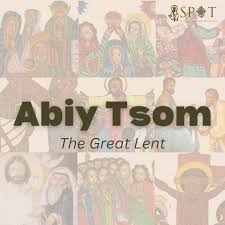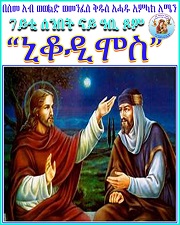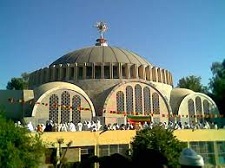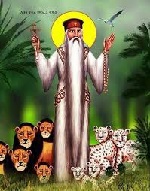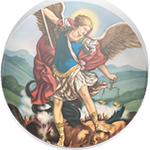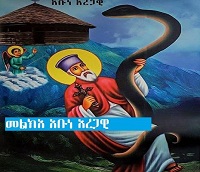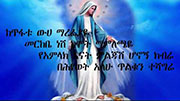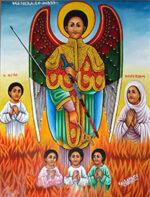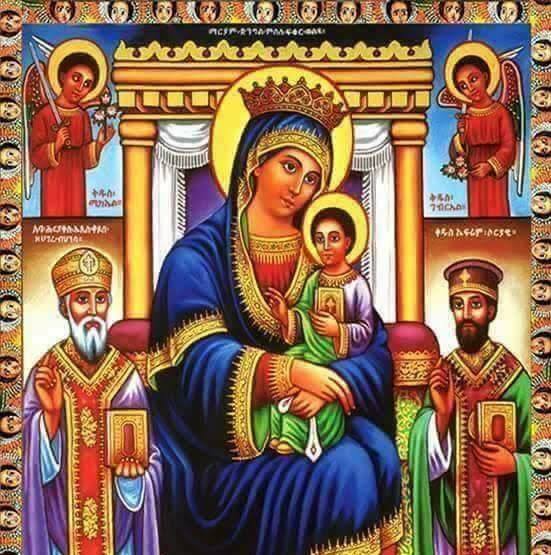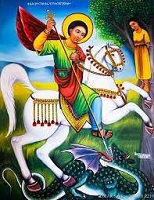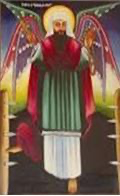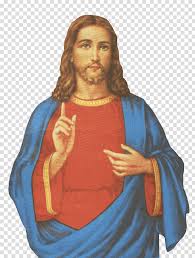History of the Church
The Ethiopian Orthodox Tewahedo Church is unique in its adherence to the faith and traditions of the prophets and apostles.
Ethiopian: refers to the unique traditions and heritage of Ethiopia as the only Christian nation to worship God, before and after the existence of written laws (The Scripture), and to accept the promise of the new Covenant.
Orthodox: means straight or true (Ortho) faith (dox). The name was adopted in 325 AD after the Heresy of Arius, who taught that Jesus Christ was created by the Father before the universe, and that He was not equal to the Father. Church scholars from different parts of the world met in Nicaea under Constantine I and declared the faith of our fathers, which is without blemish. The fathers who met in Nicaea named this faith of our fathers Orthodox (straight or the true faith) to indicate that it is a faith that has not been bent or twisted according to the wits and philosophy of men, but revealed to us by God.
It is a faith that is deeply rooted in the teaching of the prophets and the apostles. It is a faith given once to our fathers: “… the faith which was once for all delivered to the saints.” (Jude 3)
Tewahedo: means made one. It refers to the Incarnation of Christ – the complete union of His divine and human nature without mixture (without one changing the nature of the other) and without separation.
The name was adopted in 451 AD after the heresy of Eutyches, and the council of Chalcedon, which declared that Christ has two natures.
Bete Christian is the Ethiopian word for Church. “Bete” means house of. So Bete Christian literally means house or worship place of Christians. “Yet in the church I would rather speak five words…” (1Cor. 14:19). But it means more than just a place of worship, or a house of Christians:
- Each Christian is also Bete Christian: “When you come together as a church…” (1Cor 11:18)
- Bete Christian also refers to the gathering or union of Christians: “Then the churches throughout all Judea, Galilee and Samaria had peace and were edified.” (Acts 9:31)
- Bete-Christian also refers to the union of angels and saints in heaven: “But the Jerusalem above is free, which is the mother of us all.”(Gal. 4:26) “The Jerusalem that is above” is the church in heaven, the union of angels and saints.
“But you have come to Mount Zion and to the city of the living God, the heavenly Jerusalem, to an innumerable company of angels, to the general assembly and church of the firstborn who are registered in heaven, to God the Judge of all, to the spirits of just men made perfect…”
(Heb. 12:22-23)
- It also refers to the union of the faithful on earth and the saints in heaven: “You are the body of Christ, and members individually.”(1 Corinthians. 12:27)
Characteristics of the Church
- The Church is One.
“There is on body and one Spirit, just as you were called in one of hope of your calling; one Lord, one Faith, one Baptism; one God and Father of all, Who is above all, and through all, and in you all.” (Eph. 4:5-6)
- The Church is Holy.
- It is the Ark of Salvation, for all who are in it will be saved. “Walk in it; then you will find rest for your souls.” (Jeremiah. 6:16)
- It’s foundation and the head is Jesus Christ.
“Therefore take heed to yourselves and to all the flock among which the Holy Spirit has made you overseers, to shepherd the Church of God, which he has purchased with His blood.” (Acts 20:28)
“And He is the head of the Body, the Church…” (Colossians 1:18)
- It purifies those who dwell in it.
- The Church is Universal
- Jesus Christ died on the cross for all, so that all who believe in Him and fulfill his will, may be saved.
- “God did not send His Son into the world to condemn the world, but that the world through Him might be saved.” (John 3:17)
- “There is neither Jew, nor Greek, there is neither slave nor free, there is neither male, nor female; for you are all one in Christ Jesus.” (Galatians 3:28)
- The Church is ApostolicThe church is led by bishops and priests, whose line of priesthood succession goes all the way back to the apostles and Jesus Christ. Jesus Christ commissioned the disciples to teach, baptize, and make disciples. Accordingly the disciples appointed disciples (bishops & priests), who in turn appointed others to preserve the direct line of succession to this day.“Go therefore and make disciples of all nations” Mathew 28:19
Purpose of the Church
- The purpose of the church is to cleanse one of his/her sin, and make each one a child, and an heir to the kingdom of God, and God established the church with His own blood for this purpose:
“Therefore take heed to yourselves and to all the flock, among which the Holy Spirit has made you overseers, to shepherd the church of God, which He purchased with His own blood.” Acts 20:28Jerusalem Before and at the Time of the Coming of the Messiah
The Israelites came to the promise land after 400 years of bondage in Egypt. They lived under the rule of Judges[1] after the death of Joshua until the time of the prophet Samuel for about three centuries.At the time of Samuel, the rule of Judges was replaced by the rule of a king, and the Israelites remained as one nation through the rule of King Solomon. But the nation was divided into two, north and south after the reign of King Solomon: The north with ten tribes, and the South with two tribes.[2]
The North was called Israel, and the south, Judah with Jerusalem as its capital. Israel was defeated by the Assyrians around 720 BC, and it ceased to exist as an independent nation since then.
Jerusalem fell to the Babylonians under Nebuchadnezzar around 595 B.C.
After 70 years of captivity, and the conquest of Babylon by Persia, some Jews were allowed to return to Jerusalem and rebuild the city. The walls of Jerusalem were built under the prophets Nehemiah and Ezra.
In 330 BC Alexander the Great conquered the Persian Empire, and Jerusalem fell under the rule of the Greece as a result
In 63 BC, Jerusalem fell under the Roman Empire. It remained under Roman Empire when the Messiah, Jesus Christ was born.Effects of the rule of Jerusalem by Different Foreign Powers
Introduction of foreign customs and traditions: The Israelites had strict oral and written customs and traditions. But they have been exposed to a great deal of foreign customs during many years of captivity under different powers. These include different practices of worship.Creation of political and religious sects:
- Sadducees: were rich, well educated in the Laws of Moses, and consisted of the chief priests. They did not believe in the resurrection of the dead. (Matt. 22:23-24)
- Pharisees: consisted of the common people, were conservative, and hoped for the coming a Messiah who would free them from the rule of the Romans. The Pharisees, unlike the Sadducees, believed in the resurrection of the dead.
- There were also other political factions known as Zealots, who sought to expel the Romans by force. One of Jesus’ disciples, Simon was a member of this group.
(Matt. 10:4) - Another faction, known as Essenes were as zealous for Jerusalem as the Zealots, but did not believe in an armed struggle. They believed that only God could deliver them from the rule of the Romans. They used to practice an ascetic life.
-
The Birth of Jesus Christ
Jesus Christ was born:
During the 27th year of the reign of Augustus Cesar
In the 40th year of the reign Herod, in Galilee of Judea
In Bethlehem, a province of Galilee, in Jerusalem
In a manger with farm animals
In the middle of a peaceful night, a night in which angels and humans praised God in unison for the first time since the fall of Adam and Eve
Jesus Christ on earth
After Jesus Christ was born, He was exiled to Egypt because King Herod sought to kill Him. He returned to Jerusalem after three & half years, after the death of King Herod, and lived in Galilee. (Matt. 2)
He was baptized in the Jordan River at the age of 30, by John the Baptist. (Matt. 3)
He went into a wilderness right after His baptism, where he fasted for 40 days and nights, and was tempted by Satan. (Matt.4)
He started His ministry after this, and chose 12 disciples. (luke 6:12)
He went around the land of Judea, teaching the people, and performing numerous miracles, i.e. healing the sick, raising the dead…
He came into Jerusalem teaching and performing a great deal of miracles, where children and many people received Him laying their clothes and pine leaves, and singing, “Hosanna in the highest, blessed is He who comes in the name of the Lord.”
(John 12)
A few days after He arrived in Jerusalem, He was accused of:
- Transgressing the Law of Moses
- Claiming to be the Son of God
- Claiming to be a King of the Jews
- Refusing to pay tax for Cesar
Thus, the Jews took Him, and crucified Him on a Cross, with two other criminals on a Friday. (Matt. 27)
Jesus was risen from the dead on the 3rd day, as He has spoken often to His disciples. He appeared to the disciples often after His resurrection, and taught them, and opened their minds & understandings. He gave them the promise of the Holy Spirit, and commissioned them to go and “make disciples of all the nations, baptizing them in the name of the Father and of the Son and of the Holy Spirit.” (Mat. 28:19)
He ascended into heaven on the 40th day of His Resurrection.
The ‘Birthday’ of the Church
Pentecost: The disciples received the Holy Spirit, according to the promise of Jesus Christ, on the 50th day of His Resurrection (the 10th day of His Ascension). Matthias was chosen to be among the 12 disciples in the place of Judas of Iscariot, after the ascension of Jesus Christ, and before the day of Pentecost.
The day of Pentecost is considered to be the birthday of the Church, because on this day, the disciples received the Holy Spirit, and started their ministry.
As the House of Israel was established by the twelve children of Israel (Jacob), the Church was ‘born’ on the foundation of the apostles, after they received the gift and the power of the Holy Spirit.
(Eph. 2:19-21; Matt. 5:13-16)
The Era or Martyrdom
The first three hundred years of Christianity was marked by a great deal of persecution against Christians. Through a great deal of trials, tribulations and martyrdom, the Christians of the first three centuries preserved the faith.
St. Stephen is the first martyr of the first century. His death led to the exile of Christians outside of Jerusalem. But this also helped spread – the first mission of the Church outside of Jerusalem. (Acts 7 & 8)
James, the son of Zebedee (brother of John the apostle) was the first martyr among the disciples. He was martyred in Jerusalem in 44 AD by Herod Agrippa.
One of the greatest evangelists of the first century, St. Paul was converted to Christianity while on his way Damascus with a mandate to bound and bring Christians to Jerusalem. (Acts 9) He was martyred in Rome by Nero Cesar.
The faithful in Antioch were the first to be called Christians. (Acts 11:26)
The challenges during the Era of Martyrdom
- The friction among Jewish Christians, and the Gentiles who converted to Christianity (Acts 15):
This friction led to a Council of the disciples in Jerusalem – the 1st Holy Synod – and the disciples made the following decree:
The apostles, the elders, and the brethren,To the brethren who are of the Gentiles in Antioch, Syria, and Cilicia:
Greetings. Since we have heard that some who went out from us have troubled you with words, unsettling your souls, saying, “You must be circumcised and keep the law” – to whom we gave no such commandment – it seemed good to us, being assembled with one accord, to send chosen men to you with our beloved Barnabas and Paul, men who have risked their lives for the name of our Lord Jesus Christ. We have therefore sent Judas and Silas, who will also report the same things by word of mouth. For it seemed good to the Holy Spirit, and to us, to lay upon you no greater burden than these necessary things: that you abstain from things offered to idols, from blood, from things strangled, and from sexual immorality.
(Acts 15:23-29) - Persecution by the Jews (Acts 7 & 8; 9:1, 9:23; 12)
- Persecution by gentiles (Acts 14; 16:16-24; 19:21-41
- Persecution by Kings & men of power
James, the son of Zebedee was martyred by Herod Agrippa (Acts 12:1)
St. Peter & St. Paul were martyred in Rome by Nero Cesar.
John the Apostle was exiled to the island of Patmos by Emperor Domitian.
St. Ignatius was thrown to lions in an exhibition stadium by Emperor Trajan.
Decius made a decree of idol worship.
Diocletian made the following decrees to put an end to Christianity:
He made a decree to close all churches, burn all church manuscripts, and confiscate all church properties.
He also made a decree to restrict Christians from all public service & to deny them all judicial rights and privileges.
§ Many Christians used to assemble and worship in a catacomb during this period.
Heretics
nosticism[3]: the belief that human souls are trapped in an imperfect body, and a material world, and that one can be free of these through spiritual knowledge.
Sabellianism (Modalistic Monarchianism) (2nd Century): the view that “God is one in person, and it is this only person of God that was manifested at different times i.e. God the father was incarnate and manifested as Jesus Christ, and was later manifested as the Holy Spirit” This heresy was taught by Sabellius, a native of Libya.
Dynamic Monarchianism (3rd Century): The belief that “Jesus was a mere man, until he received divine wisdom and power when God dwelled in him after He was baptized in the Jordan River.” Paul of Samasota, a Syrian theologian was the architect of this view, and his teaching was condemned in a council of Bishops in Antioch in 269 AD.
All these hardships and challenges did not destroy the church, but strengthened it. One of the early fathers of the Church said: “If you fight against a man, you may defeat him of you may be defeated. But it is impossible to defeat the Church. The church is always in a struggle, but is never defeated.”
Ecumenical Councils
- The First Ecumenical Council of Nicaea (325 AD)
The Issue: The heretic teaching of Arius – that ‘the Son of God is a created being, and did not co-exist eternally with the Father.’ Arius was condemned by the Church of Alexandria in 321 AD.
Outcome: The council of Nicaea was called by Constantine I. Three Hundred Eighteen bishops and scholars attended the council, and condemned the teaching of Arius, and excommunicated Arius and His followers. The Nicene Creed was written at this council as a statement of the Orthodox Faith.
- The First Ecumenical Council of Constantinople (381 AD)
The Issue: The heresy of Macedonius – that ‘the Holy Spirit has no form and Divinity.”
Outcome: 150 Church fathers met at this council, denounced this heresy and excommunicated Macedonius with his followers. The article of faith about the Divinity of the Holy Spirit was added to the Nicene Creed at this council.
- The First Ecumenical Council of Ephesus (431 AD)
The Issue: The heresy of Nestorius – that ‘Jesus had two persons and two natures, and the Virgin Mary gave birth to the human person of Jesus, and therefore should not be called the mother of God (Theotokos).’Outcome: 200 church fathers assembled in this council, denounced this heresy, and excommunicated Nestorius and his followers. The council, under the leadership of St. Cyril of Alexandria decreed Jesus Christ as one person, and that the Virgin Mary should be called Theotokos – mother of God.
- The Second Ecumenical Council of Ephesus (449 AD) The Issue: The heresy of Eutyches – that ‘the humanity of Jesus Christ is absorbed by His Divinity.’Outcome: Eutyches was accused of the above-mentioned Heresy by Flavian, Patriarch of Constantinople. But Eutyches denied the charges and declared to accept the first three Ecumenical Councils. Thus he was absolved of Flavian’s condemnation. But St. Dioscoros, chairman of the Council of Ephesus, later anathemized Eutyches because he continued to spread the heresy he was accused of.
The Pope of Rome was not present at this council, and only sent a letter in support of Flavian – and declaring two natures in the one person of Jesus Christ. This was a contradiction to the church’s teaching and the teaching of St. Cyril of Alexandria – a teaching that was upheld as Orthodox in 432 & 433 AD (after the First Council of Ephesus).
- The First ‘Ecumenical’ Council of Chalcedon (451 AD) The Issue: The heresy of Eutyches and the Second Ecumenical Council of Ephesu
Outcome: The Pope of Rome was not present at this council, but sent a letter in support of a new doctrine – that ‘Christ has two distinct natures in one person.’ Dioscorus was not allowed a seat in the council. Instead he was condemned for refusing the Pope’s new doctrine. The sour outcome of this council was a schism among the Church: Chalcedonian & Non-Chalcedonian. Dioscoros was exiled by the emperor, Marcian.The Non-Chalcedonian Christians are the Oriental churches that are in communion with each other. These are the Ethiopian, the Coptic, the Armenian, the Syrian and the Indian Orthodox churches.
The Chalcedonian churches later split among themselves at 1054 AD over the issue of papal primacy over the other patriarchs & the filioque clause – a clause added to the Nicene Creed by the pope that ‘the Holy Spirit proceeds from the Father & the Son.’
The Beginning and Expansion of Islam
- The Islamic Religion was started around the beginning of the 7th century.
- In 630 AD, Mohammed, the first prophet of Islam, took over Mecca.
- In 636 AD, Jerusalem, in 639 AD, Syria, and in 641 AD, Alexandria was taken over by Muslim Arabs.
- Between 639 AD & 717 AD, Most of North Africa was taken over by Muslim Arabs.
- The first schism of the church after the council of Chalcedon led to the rapid expansion of Islam in the Middle East and North Africa. Most of the regions that were taken over by the Muslims were strong and historical centers of Christianity. Growing schism among Christian nations led to the fall of Alexandria (641 AD) and most of North Africa (639 – 717 AD) under Islam.
Protestantism
- Martin Luther was a 16th century reformer, who began the Protestant reformation.
- He was brought up as a devout catholic, and became a monk.
- His 95 theses in protest of the sale of indulgence (reduction or exchange of temporal punishment for financial contribution) to finance the construction of St. Peter Basilica sparked the protestant reformation.
- Through this protest, Martin Luther introduced new teaching central to the protestant reformation:
Justification by Faith: Only faith, and not works, is essential for salvation.
Universal priesthood: That everybody is a priest.
Bible as the sole authority: The Bible is the only source of the Christian faith. Tradition is not essential.
- There was a schism within the protestant reformation from the beginning into the Lutheran and the Reformed Churches.
- The 16th century was marked by a great deal of reformation movement, and the political separation of the Church of England from the Catholic Church.
- The reformation movement was started to make changes within the Catholic Church, but with the break up of the Church of England, and the excommunication of Martin Luther, the movement led to a schism from the Catholic Church, and the creation of many other protestant movements throughout Europe.
- As a result different protestant sects that rejected infant baptism, the devotion to the Virgin Mary, intercession of saints, and many other church sacraments were created.
History of Christianity in Ethiopia
- Ethiopia is known as the land of Kush in the Bible.
- Kush is the grandson of Noah – the 10th generation patriarch from Adam.
- Kush also used to be called Ethiopis. He came to Ethiopia with Abis & Saba. Accordingly the land was called the land of Kush, Ethiopia (derived from Ethiopis) and Abyssinia (derived from Abis).
- Kush brought with him the practice of Judaism, and thus Ethiopians used to worship God even before the existence of the Scripture. The fact that Moses wife was Ethiopian is a testament of this fact.
(Numbers 12) - The Old Testament came to Ethiopia with the Ark of the Covenant through King Minilik I, the son of Solomon & Queen of Sheba. (1Kings 10:9) Priests and different goods of worship also came to Ethiopia with the Ark of the Covenant at this time.
- There are many historical sites that bear witness to Judaic worship in different parts of Ethiopia, which served as centers of religious worship since this period.
- There is a strong consensus among Church historians and scholars that one of the kings who brought gifts to Jesus Christ at the time of His birth was an Ethiopian. There are some who argue that all were Ethiopian. (Myrrh, one of the gifts the kings presented to Jesus Christ, is a resinous material derived from a tree native to Ethiopia.)
- Christianity was introduced in Ethiopia just a year after the resurrection of Jesus Christ, through the Ethiopian Eunuch, Bachos – who was baptized by Philip in 34 AD while on a pilgrimage to Jerusalem.
(Acts 8) It is also believed that Ethiopians were among the 3000 who believed and were baptized on the day of Pentecost. (Acts 2:41)
- But the order of the priesthood came to Ethiopia in the early forth century through Frumentius (Abuna Selama). Abuna Selama was ordained a bishop by St. Athanasius in 351 AD, and Christianity became the state religion ever since he returned to Ethiopia as a bishop.
- Abuna Selama translated the New Testament into Ge-ez, and introduced the sacrament and the sacrifice of the New Covenant to replace Judaic sacrifice of the Old Covenant.
- Christianity was further spread to many parts of Ethiopia through the famous 9 saints who came to Ethiopia seeking shelter from the persecution of Chalcedonians, after 451 AD. They embraced the culture and the language of Ethiopia and founded monasteries that became centers of theological studies and monastic life to this day.
- Abuna Gebre Menfes Kidus and Abuna Teklehaimanot are among the most notable saints that spread Christianity to the remote parts of Ethiopia.
- Ethiopian Christianity survived through many years of hardships:
The Ethiopian Eunuch certainly faced resistance from the Ethiopian Jews when he returned to Ethiopia with the gospel.
St. Athanasius of Alexandria was exiled by sympathizers of the Arians after the First Council of Nicaea. These sympathizers also tried to replace Abuna Selama, for he was ordained by St. Athanasius.
King Caleb of Ethiopia went to Nagran, southern Yemen, to save Christians from the oppression by Jews. He made a vow to give up his crown if God would give him victory. He came back victorious, and gave up his throne according to his promise to lead a monastic life.
The Islamic rulers of Egypt had a great deal of influence on the missions of the bishops who came to Ethiopia from Egypt. The first mosque in Ethiopia was built by an Egyptian bishop (probably in exchange for ease the burden of Christians in Egypt). Ethiopia was left without a bishop for several years due to the restrictions imposed by the Islamic rulers of Egypt.
Yodit Gudit, a Jewish woman took advantage of a weakening monarchy, came to power in the 8th century. She ruled for 40 years, during which she destroyed many churches, obelisks and manuscript.
The Islamic Jihad (1527 – 1542) under Ahmed Gragn (the left handed) led to the destruction of many churches, monasteries and manuscripts. Many Christians were martyred during this period, and others changed their faith for fear of being massacred. Ahmed led such massacre with the aid of foreign Islamic fighters. The ill effects of his brutal campaign are felt to this day.
The Portuguese, who came to help Ethiopian Christians from onslaught of Ahmed Gragn, created a doctrinal controversy that led to the conversion of King Suseneyous to Catholicism. He persecuted and martyred many of the faithful in an effort to convert the people to the Catholic faith. The faithful were subjected to another affliction, before the wounds from the Islamic invasion healed.
When the son of Soseneyous, Fassiledes, came to the throne after his father’s death, he looked at the suffering of the people, and forced the Portuguese to leave the country. He proclaimed the Orthodox faith again as the official faith of the nation.
The Italian occupation of Ethiopia during the 2nd world war was accompanied by brutal massacre of the faithful and the clergy. The 20th century saint of the Ethiopian Orthodox Church, Abuna Petros, was executed by the Italians for refusing to pledge support for the occupation and for openly condemning the invasion.
- The perpetration against the church continues to this day. Islamic fundamentalists are burning churches and literally butchering the faithful in different parts of the country. Islamic terrorists are proclaiming a ‘holy war’ against Ethiopia and Christianity.
- On the other hand, Protestants, supported by foreign evangelicals, are trying to convert the faithful from the Orthodox faith. These and Islamic fundamentalists pose the greatest challenge to the Ethiopian Orthodox Church in the new Millennium.
- But the Church is built upon a solid foundation, which cannot be moved or destroyed by any power: “the gates of Hades will not overcome it.” (Matthew. 16:18) So has it survived to this day, and will continue to survive to the end.
- The Ethiopian Orthodox Tewahedo Church gained complete autocephaly from the Coptic church in 1959 with the ordination of His Holiness Abuna Baslios, as the first Patriarch of Ethiopia, in 1959.
- Judges were rulers of Israel who were divinely empowered to rule and save the people of Israel before they asked for a King. Samuel is the last of the Judges
- God forsook Israel, and caused the split of the nation because of King Solomon’s deeds: building temples of idols for his Egyptian wives, and worshipping them. (1 Kings 11:1 – 13)
- There are many forms of Gnosticism, but Gnostics generally believe that there is an imperfect god who created the material world, and a perfect and good god, who created the spiritual world. This heresy existed since the first century and considered knowledge superior to and independent of faith. (en.wikipedia.org)

